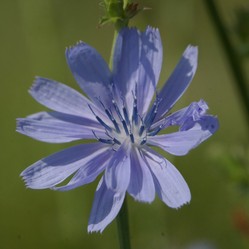Common chicory (Cichorium intybus) is a member of the sunflower family. The plant is native to Europe, but now also grows in North America and Australia.
Chicory root can be brewed as a tea and often used as a coffee substitute or coffee and chicory blend. The roasted root smells like coffee, but chicory has no caffeine. Some beer brewers use roasted chicory to add flavor to stouts and ales.
The plant leaves can be used like salad or cooked like spinach. Chicory grown commercially is cultivated and not as bitter as wild chicory (called common chicory). But if you gather the smaller leaves for salad and cook the greens in a couple of batches of water, fresh chicory will taste better.
Chicory is also valuable to insect and animal life.
I took all the photographs of chicory for this article. The photos were taken in east Tennessee, but I've seen chicory in other U.S. states, too. ~~ Burntchestnut (Angela Johnson)


 Some people call chicory a weed, although it's actually an herb. Chicory often grows along roadsides and in fields. I've seen it growing at the edges of lawns and along street curbs, too. When it's mowed, the flowers bloom low to the ground and it's quite attractive. Chicory grows best in full sun and blooms from June to October.
Some people call chicory a weed, although it's actually an herb. Chicory often grows along roadsides and in fields. I've seen it growing at the edges of lawns and along street curbs, too. When it's mowed, the flowers bloom low to the ground and it's quite attractive. Chicory grows best in full sun and blooms from June to October.
 You can eat common chicory leaves. Pick young leaves in March, and again in November when new leaves emerge (older leaves taste bitter).
You can eat common chicory leaves. Pick young leaves in March, and again in November when new leaves emerge (older leaves taste bitter).




 Chicory is used for an upset stomach, loss of appetite, a tonic to increase urine production, to protect the liver, gallbladder disorders, constipation, cancer, and rapid heartbeat.
Chicory is used for an upset stomach, loss of appetite, a tonic to increase urine production, to protect the liver, gallbladder disorders, constipation, cancer, and rapid heartbeat.


 The chicory flower attracts bees and butterflies, and rabbits and other game animals eat the plant. Chicory is high in fiber and easily converts to sugar, making it suitable for livestock feed.
The chicory flower attracts bees and butterflies, and rabbits and other game animals eat the plant. Chicory is high in fiber and easily converts to sugar, making it suitable for livestock feed.



 I Loved to Read in Grade School (in the 1960s)on 09/29/2018
I Loved to Read in Grade School (in the 1960s)on 09/29/2018
 Halloween Memories from the 1960son 09/17/2018
Halloween Memories from the 1960son 09/17/2018
 What on Earth is Earthing?on 06/03/2015
What on Earth is Earthing?on 06/03/2015
 Worm Manure (Castings) Is The Best Organic Fertilizeron 05/25/2015
Worm Manure (Castings) Is The Best Organic Fertilizeron 05/25/2015



Comments
Only few decades ago a coffee substitute made of chicory was still a regular on the shelves in our markets and now only oldest people know this humble yet very useful plant. It's good to have this article, chicory deserves it.
frankbeswick and whitemoss - I think you'll be happy with chicory. I took dozens of photographs, including butterflies In Tennessee, where these photos were taken, only a black butterfly was attracted to the bloom (along with bees). It could have been the most popular butterfly in the area because these butterflies were on many other flowers as well.
Depending on when I visit my sister next, I'd like to try eating some of the greens and roast the roots.
Great article. I have been seeking to develop my range of crops, and you have given me an idea.
Now here is something that I don't already grow that I like the look of!